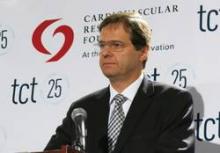SAN FRANCISCO – Adverse event rates 1 year after implantation of a second-generation zotarolimus-eluting coronary stent were similar for 3,120 patients regardless of whether they took 3 months or 12 months of dual-antiplatelet therapy in a prospective trial that randomized 3,120 patients in real-world settings.
Six percent in the 3-month group and 5.8% in the 12-month group developed one or more adverse events that were included in a composite primary endpoint: death from any cause; myocardial infarction; stroke; or major bleeding, Dr. Fausto Feres and his associates reported at the Transcatheter Cardiovascular Therapeutics annual meeting. The results were significant in a noninferiority analysis.
The results should comfort clinicians who think they have to stop dual-antiplatelet therapy (DAPT) earlier than recommended in some patients who are at higher risk for bleeding complications, such as the elderly and patients with a history of hemorrhagic events, said Dr. Feres, an interventional cardiologist at the Instituto Dante Pazzanese de Cardiologia, São Paulo, Brazil, an institution known for pioneering stent procedures.
The study tapped 33 clinical sites to enroll Brazilian patients who were undergoing percutaneous coronary intervention (PCI) with the second-generation Endeavor zotarolimus-eluting stent. All patients had stable or unstable angina or a recent MI, at least one coronary lesion suitable for PCI with the Endeavor stent, and a native vessel diameter of at least 2.5 mm with stenosis greater than 50%. The cohort consisted mainly of patients with stable coronary artery disease and a low risk of acute coronary syndrome.
Equal numbers were randomized to 3 or 12 months of DAPT with aspirin and 75 mg/day of clopidogrel to reduce the risk of thrombotic events. Current guidelines call for 12 months of DAPT after stent implantation. One-year follow-up data were available for 98% in each group.
Known as the OPTIMIZE trial (Optimized Duration of Clopidogrel Therapy Following Treatment With the Endeavor Zotarolimus-Eluting Stent in Real-World Clinical Practice), the study found that more than 99% of patients in each group completed 3 months of DAPT. One year after stent implantation, 6% who had been randomized to the 3-month group were still on DAPT, as were 97% of those randomized to the 12-month group.
The individual components of the combined endpoint did not differ significantly at 1-year follow-up. All-cause mortality was seen in 1.9% and 1.7% of the 3- and 12-month therapy groups; MI rates were 0.8% and 0.6%, respectively; stroke rates were 0.3% and 0.1%; and major bleeding occurred in 0.2% and 0.4%. Landmark analyses also found no significant differences between groups for these endpoints at 3 months.
Rates of definite or probable stent thrombosis at 1 year were 0.3% in the 3-month therapy group and 0.1% in the 12-month group, which was not a significant difference. There was a trend toward higher risk of bleeding at 1 year in patients on 12 months of DAPT, seen in 1% compared with 0.4% of those on 3 months of therapy, Dr. Feres reported at the meeting, cosponsored by the American College of Cardiology.
Secondary outcomes at 1 year showed that rates of other adverse clinical events also did not differ significantly between the two groups. Eight percent in the 3-month group and 7% in the 12-month group developed one or more major adverse coronary events: death, MI, emergent coronary artery bypass grafting, or target lesion revascularization. Three percent in each group died, 3% in each developed an MI, 4% in each had either cardiac death or an MI, and 0.3% in each developed a stroke. Major bleeding occurred in 0.6% of the 3-month group and 0.9% of the 12-month group. Target lesion revascularization rates were 3.5% in the 3-month group and 3.2% in the 12-month group.
Results did not differ by subgroups.
Rates for the primary outcome were lower than expected in both arms of the trial. Investigators expected a 9% rate, not the roughly 6% rate seen in both arms. The rate of major adverse coronary events at 1 year, however, was 8.4% in the 3-month group and 7.5% in the 12-month group.
Two previous studies in Italy and Korea of shortened-duration DAPT for patients receiving drug-eluting stents compared 6 months of therapy with 12 months of therapy. One other previous trial compared 3 months with 12 months of DAPT but compared two different stents, he said. All suggested that 12 months of DAPT may not always be needed, he said in an interview.
The current study excluded patients with primary or rescue PCI for ST-segment elevation MI, lesions located in a saphenous vein graft, patients with a previous PCI with a drug-eluting stent, and other less common exclusion criteria.


